
August 2012
Unmasks ANC Neo-Apartheid Regime
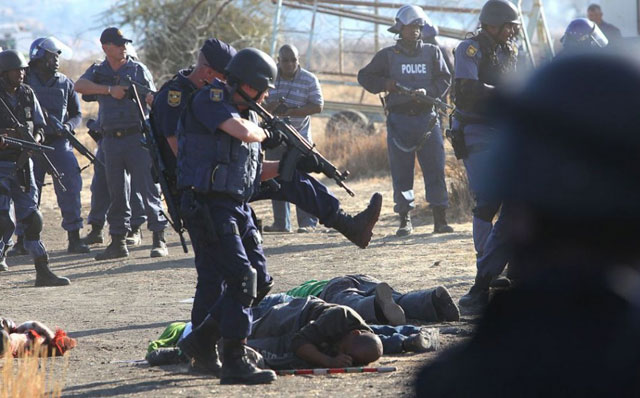
South African police pose with guns drawn over their victims. Then the ANC authorities charged the
victims with murder under a law from the apartheid regime. (Photo: Alon Skuy/The Times of Johannesburg)
AUGUST
29 – It
was, by far, the bloodiest massacre of
black people in South Africa since the
end of the apartheid regime of
institutionalized white supremacy. The
images recalled the horror of
Sharpeville (1960) and Soweto (1976) –
only this time it was a black president
and ministers who presided over the
slaughter of striking miners. The
capitalist government of the African
National Congress (ANC) and its
“partners” of the South African
Communist Party (SACP), backed by the
National Union of Mineworkers (NUM),
acting on behalf of one of the world’s
top mining companies, sought to police
the workers and put a violent end to
their walkout.
On August
16, an elite force of hundreds of
South African cops opened fire on
workers of the Lonmin mine in Marikana
with automatic rifles, using live
ammunition at point-blank range. Three
dozen strikers were killed, another 80
or so seriously injured and 259
arrested in the assault. Although the
murderous police claimed to be acting
in self-defense, many of the miners
were shot in the back and in the head.
After the shooting was over, police
posed for photographs with guns
pointed at the dead like big game
hunters standing over their prey, or
U.S. troops grotesquely displaying
their kill in Afghanistan. It was
cold-blooded mass murder in the
service of capital.
The
carnage was systematically prepared,
and the shoot-to-kill orders came from
the top, from the cabinet of ANC
president Jacob Zuma. This bloodbath
will likely mark the turning point
where significant sectors of the
non-white masses lost their illusions
in rulers who have traded on their
liberation credentials for the last 18
years. Far from presiding over a
“post-apartheid” South Africa, the
popular-front Tripartite Alliance of
the ANC, SACP and Congress of South
African Trade Unions (COSATU) has
instituted a neo-apartheid
capitalist regime, still
subjugating the impoverished black
working people in the interests of the
same capitalist masters.
Meanwhile,
over 250 Lonmin workers are still
being held in jail, grotesquely
charged with the murder of their
comrades killed by the police! Company
management has declared that they will
not be allowed back, even as it issues
one ultimatum after another ordering
strikers to return to work – to no
avail. The 28,000 workers of the
world’s richest platinum mine, owned
by the London-based conglomerate, are
refusing to go back until their demand
is met to raise their wages from a
miserable take-home pay of 4,000 rand
(US$480) to R12,500 (US$1,500) a
month. Workers
everywhere should mobilize in
solidarity with the South African
miners, calling for victory to the
strike, cops get out, drop the
charges and reinstate all the
strikers!
Popular-Front
Bloodbath
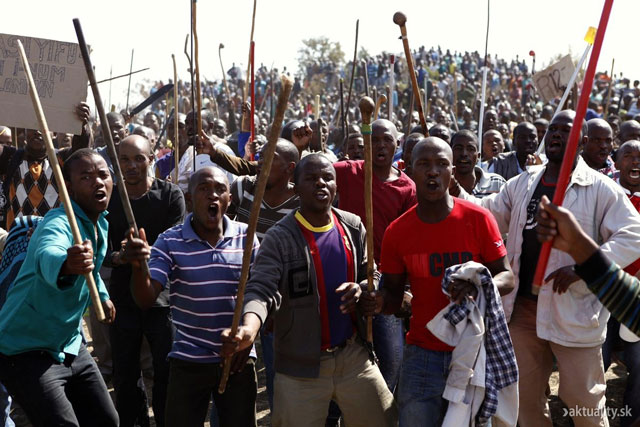
Miners in Marikana before the August 16 slaughter. Police claimed they had to fire their automatic
rifles in “self defense,” against workers armed with sticks. (Photo: Reuters)
The
3,000 rock-drill operators at Marikana
began the walkout on August 10,
demanding a tripling of their wages
which leave them mired in poverty in
makeshift shacks while some workers
still live in hostels. The walkout was
promptly declared “illegal” by the
capitalist courts, and several
thousand police were
quickly dispatched to the area. The
strikers camped out on a hill near the
shantytown where some live, well away
from company property. The cops
surrounded them and brought in the
infamous nyala
or “hippo” armored vehicles which
were the terror of anti-apartheid
demonstrators.
The
bourgeois press has sought to portray
the miners’ struggle as a dispute
between two unions, a “bloody turf
war” (Sowetan,
27 August) of the Mineworkers and the
“breakaway” Association of Mineworkers
and Construction Union (AMCU). Lonmin
workers complain that the
once-militant NUM has become too cozy
with the employers and some now
support the AMCU. No wonder. On
Wednesday, August 15, a convoy
including NUM president Senzeni
Zokwana arrived at the site and parked
in the cop laager. Entering a police nyala
which drove to within loudspeaker
range of the workers, Zokwana told the
workers to go back. The crowd refused
to listen, and when they called on him
to get out and speak with them
directly, Zokwana fled.
AMCU
president Vusimuzi Mathunjwa showed up
a few minutes later and addressed the
strikers. While he got a warm
reception, his appeal for the strikers
to disperse – citing the threat of
police violence – so he could
negotiate their demands with
management was also turned down. Up to
3,000 camouflage-wearing riot-control
police surrounded the strikers and
cordoned them off with barbed wire.
The miners had already been fired on
days earlier, allegedly by NUM
snipers, with several killed. Two
police and two security guards were
also killed, which the media blamed on
the strikers and the NUM leaders
pinned on the “upstart” union. In any
case, class-conscious workers shed no
tears for these professional
repressors.
On
Thursday, August 16 Lonmin management
issued a “final ultimatum” ordering
the strikers back to work. Workers
demanded instead that the police leave
the area. A police spokesman announced
that this was “D-day” and that they
had “no option but to disperse them
[strikers] by force.” AMCU leader
Mathunjwa begged workers to leave
saying the police were set to kill,
but when they wouldn’t he took up the
miners’ vow, “We're going nowhere. If
need be, we’re prepared to die here” (Mail
& Guardian, 17 August).
Police advanced on the hill where the
strikers were gathered, firing tear
gas and then using a water cannon, but
the combative workers kept singing
struggle songs and waving machete-like
pangas. The police then opened up with
their heavy artillery and soon the
field near the Wonderkop squatters
settlement was littered with bodies.
Police “hippos” drove over wounded
workers. The Sowetan
(17 August) reported:
“A
defiant mineworker, who was lying on
the ground bleeding from a gunshot
wound, kept on swearing at the police
and urged them to finish him off,
saying ‘kill us to please abelungu
(whites)’.”
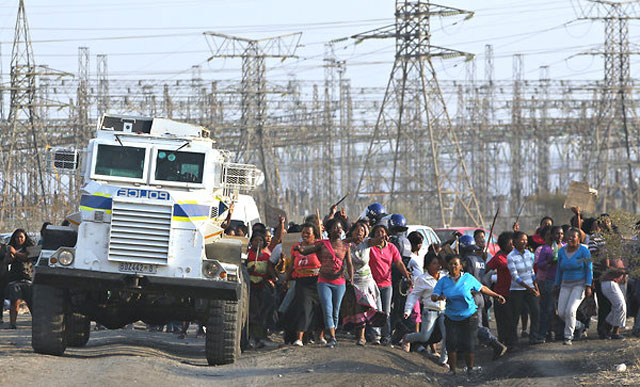
Women in the Wonderkop settlement near the mine undeterred by police "hippo" armored vehicle.
(Photo: Themba Hadebe/Associated Press)
The cop
rampage was premeditated mass murder,
yet what was the response? After a
couple of days, Zuma issued an
“even-handed” statement that “killing”
was “unacceptable.” Three different
“inquiries” have been instituted, but
police authorities are unapologetic.
They claim the first shots were from
the strikers, although only police
bullets have been found. National
police commissioner Riah Phiyega
claimed that the 423 police on the
front line were “forced to utilize
maximum force to defend themselves”
from the “militant group” brandishing
“dangerous weapons” (spears, sticks,
pangas, knives). A few days later, she
told police, “Don't be sorry about
what happened.” Yet while the strikers
took 112 casualties, between dead and
wounded, only one cop was slightly
injured.
Even more
grotesque was the response of the NUM
and SACP leaders. Before the massacre,
Mineworkers general secretary Frans
Baleni had egged the police on,
referring to earlier killings by cops
and asking “In this case they don’t
act?” After the shooting, the NUM
blamed the AMCU for awakening
unwarranted hopes. The Communist
Party, whose new national chairman is
the very same NUM president Senzeni
Zokwana, issued an even more vile and
scurrilous statement claiming that the
police slaughter was a “barbaric act
co-ordinated and deliberately
organized by AMCU leader Mr. Mathunjwa
and Steve Kholekile,” and calling for
the immediate arrest of Mathunjwa and
Kholekile! It also called on a
presidential commission to investigate
the “violent nature and anarchy
associated with AMCU wherever it
establishes itself,” and for
amendments to the Labour Relations Act
to make it more difficult to found new
unions (SACP North West Statement, 17
August).
The NUM and SACP
tops are acting as scab-herders,
strikebreakers and instigators of
police murder of workers. But while the scope of the
massacre has shaken ANC-ruled South
Africa to its foundation, this
treacherous action by labor
“statesmen” and self-proclaimed
“communists” is hardly new. Such
deadly backstabbing is the ultimate
recourse of all manner of reformists
when the capitalist system they
support is at risk. In particular, it
is the deadly face of the popular
front, in which workers
organizations (parties, unions) are
chained to a political alliance with a
section of the bourgeois ruling class,
acting as a roadblock to revolution or
militant class struggle. One need only
look at Spain in the 1930s where under
the popular-front government
(including the anarchists), the
Stalinist Communist Party spearheaded
murderous repression of the left and
workers in the name of combating
Trotskyism – that is, the spectre of
proletarian revolution.
Black
Capitalist “Economic Empowerment” =
Poverty for Black Workers
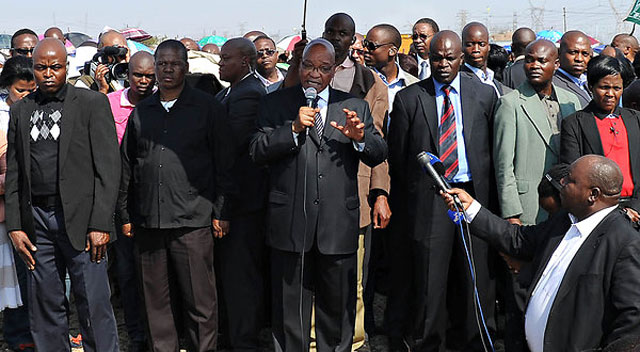
South African president Jacob Zuma (ANC, former SACP political bureau member) finally showed up
in Marikana six days after massacre to offer empty condolences. Workers refused to listen. (Photo: AFP)
“We
thought the person we voted for would
have come with our brothers who have
been arrested.”
–Miner
Xolani Ndzuza, among those protesting
the visit by South Africa’s ANC
president Jacob Zuma, quoted in
“Marikana: The New War,” Sowetan,
23 August
The
Marikana mine massacre has acted as a
spotlight, throwing into sharp relief
the brutal reality of capitalist South
Africa under the administration of the
African National Congress and its SACP
“younger brother” (as ANC deputy
chairman Kgalema Motlanthe put it at a
gala fundraiser in Durban during the
party’s 13th national
congress last month). As has been the
case of anti-colonial movements
elsewhere in Africa, the
petty-bourgeois nationalists have
become bourgeois nationalists upon
taking power. In South Africa they
became junior partners in the existing
capitalist class based on the
white-supremacist apartheid order.
While the color of faces in government
changed, the fundamental structure of
South African capitalism did not. And
the SACP, which long ago became a
leading component of the ANC, signed
on as advisors, administrators and
most importantly enforcers
of this neo-apartheid regime.
No
matter who gave the order to open fire
on the strikers, the murderous action
of the police at Marikana was the
logical consequence of the policies of
the ANC/SACP/COSATU Tripartite
Alliance. It was President Zuma, a
former SACP political bureau member,
who pushed for militarizing the South
African Police Service in the name of
“fighting crime.” In 2009, police
commissioner “general” Bheki Cele
called on police to “shoot to kill”
criminals. Deputy police minister
Fikile Mbalula likewise urged cops to
“shoot the bastards,” saying “innocent
people are going to die” in explaining
away the police murder of a
three-year-old child. And the police
have done just that, with over 1,700
civilians reportedly dying as a result
of police action or in police custody
in 2010. This finally led to an outcry
about police brutality when cops beat
Andries Tatane, a teacher, to death
during a protest last year. But it
hasn’t stopped the killing spree.
Meanwhile, under the watchword of Black Economic Empowerment (BEE), some of the top figures in the ANC (and the SACP/ANC-led unions) have struck it rich, turning into multimillionaires and front men for major imperialist corporations. Under the South African version of “crony capitalism,” many of the smaller fry have become “tenderpreneurs,” setting up companies that live off of tenders (contracts) to supply outsourced services to the government and state-owned enterprises (often eliminating union jobs) in the name of “local procurement.” SACPers get to be junior ministers (general secretary Blade Nzimande is minister of higher education, deputy gensec Jeremy Cronin is deputy minister of public works) or trade-union leaders, like Zokwana, whose job is to keep the workers in line.
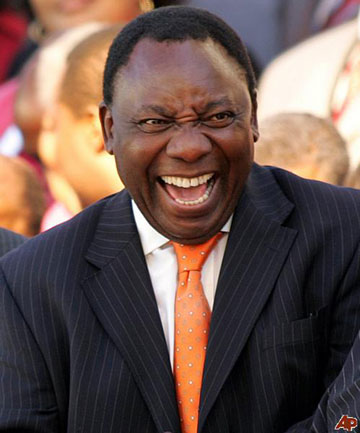
Laughing
all the way to the bank. Cyril
Ramaphosa, and many other ANC
leaders have become a dependent
black sector of the South
African bourgeoisie. The founder
of National Union of Mineworkers
is now a mining magnate, member
of the board of Lonmin. Photo
from profile of wealthiest
Africans in Forbes
magazine, “the capitalist tool.”
(Photo: AP)
Notably, Cyril Ramaphosa, who started out as the founding leader of the National Union of Mineworkers and built it into South Africa’s largest and most powerful union, has gone on to greener pastures. After becoming head of the ANC in 1991, he led its negotiations with the ruling Afrikaner National Party, chaired the constitutional assembly and was an important figure in the ANC-Nats unity government which took office in 1994 under Nelson Mandela as South African president. After losing out in the race to replace Mandela, Ramaphosa went into the private sector, founding the Shanduka Group (newsprint, mining, Coca-Cola, McDonald’s), becoming chairman of the Bidvest Group (food services and distribution) and a director and stockholder of Lonmin Plc, the very company he once fought against when it was Lonrho Plc under apartheid.
Ramaphosa is hardly alone. Another ANC leader (and former member of its armed wing, Umkhonto we Sizwe), Tokyo Sexwale, currently minister of human settlements, founded Mvelaphanda Holdings which is South Africa’s third biggest diamond mining company. All of these outfits are beneficiaries of the BEE program to create black capitalist subsidiaries of imperialist capital. But the Ramaphosas and Sexwales are not the only ones on the gravy train. Last year, NUM general secretary Frans Baleni awarded himself a 40% raise, raking in R1.4 million (US$166,000) annually, while the striking miners at Lonmin, who Baleni ordered to end their strike, toil underground in extremely dangerous conditions for less than US$6,000 a year.
And the miners are far from the lowest paid group in South Africa. The numbers of migrant laborers without any rights have increased under neo-apartheid. By virtually every measure, South Africa along with Brazil are the two most unequal major countries in the world. Significantly, both are presided over by popular-front capitalist governments which rest on powerful labor movements (that must be kept in check at all costs) while assiduously following the free-market “neo-liberal” economic policies dictated by Wall Street, Washington and the international bankers’ cartels. And the inequality is not color-blind: among the poorest one-fifth of the South African population, 70% are unemployed and over 95% are black, according to a recent study by the World Bank (South Africa Economic Update, July 2012).
Thus the Marikana strike is not just a wage dispute. It is a revolt by the impoverished black working people against a black capitalist regime that claimed to represent them while the leaders enriched themselves shamelessly. The struggle at Lonmin follows a six-week strike by miners at Impala Platinum (Implat) at the beginning of the year, also directed against the NUM tops. And the mine wars come amid a wave of roiling protests in the urban “townships” against inadequate or non-existent government delivery of services (the “toilet wars”). Rail lines and highways have been blocked from Kayelitsha outside Cape Town, where the business-led Democratic Alliance governs, to the ANC-governed Eastern Cape (East London, Port Elizabeth, Grahamstown) and Gauteng (Metropolitan Johannesburg, including Soweto) provinces. This revolt of the poor contains the seeds of revolution.
Marikana
Revolt: Seeds of Revolution
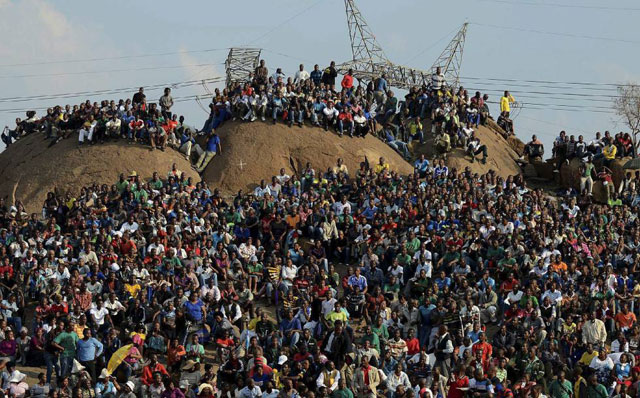
Thousands attended memorial meeting for the slain strikers on the hill outside the mine, August 23.
(Photo: European Press Agency)
The downtrodden black, coloured (mixed-race) and Indian working people placed their hopes in Nelson Mandela and the African National Congress to overcome the brutal oppression and repression of apartheid. For many, the Marikana massacre may well lead to the realization that the ANC regime backed by the SACP and COSATU unions is in fact their enemy and a tool of continued white capitalist rule. For supporters of the South African Communist Party and others on the left who tailed after and promoted the illusions of the masses in the petty-bourgeois nationalists, the bloodbath dramatically exposes the bankruptcy of their Stalinist/Menshevik policy of “revolution in stages.” What resulted was not “liberation” from white colonial domination but the renewal and strengthening of South African capitalism with the addition of a subordinate black sector, centered on the ANC leadership, which now joins in extracting superprofits from black labor.
In the case of some renegades from Trotskyism, notably the U.S. Socialist Workers Party (SWP) of Jack Barnes, the policy of political support to Mandela’s ANC was a key element in their explicitly renouncing permanent revolution in the mid-1980s. Barnes’ 1985 article on “The Coming Revolution in South Africa” (New International, Fall 1985) flatly declared the goal to be a “bourgeois democratic revolution” and “not an anticapitalist revolution.” Like the SACP, the U.S. SWP called for a “national democratic revolution.” But rather than “open[ing] the road to the transition to an anticapitalist revolution” sometime in the indefinite future, the establishment of the ANC regime only masked the continuation of a neo-apartheid system based on the superexploitation of black workers. The Marikana massacre by the ANC government on behalf of Lonmin with ANCer Ramaphosa on its board of directors is Exhibit A.
The genuine liberation of the oppressed black African and coloured working people from grinding poverty and deprivation of effective democratic rights can only come about through Leon Trotsky’s perspective of permanent revolution. As we wrote about a debate in the SACP and the South African left in the mid-1990s:
“While the elaborate legal structure
of grand and petty apartheid has been
dismantled – passbooks, the Group
Areas act which banished millions to
barren ‘bantustans’ and townships, the
ban on mixed marriages, etc. – the
underlying economic structure remains.
White supremacy is vital to South
African capitalism, and can only be
eliminated through socialist
revolution.”
–“In
Defense of the Dictatorship of the
Proletariat,” The Internationalist
No. 3, September-October 1997
Moreover, a class-struggle response to the bloodbath sharply poses the urgency of a program challenging the racist rule of capital, as laid out in Trotsky’s 1938 Transitional Program. For a start there is the crying need for workers defense guards to protect strikers. We join the family members of Marikana workers in demanding cops get out! And while SACPers include top leaders of the POPCRU police union, Trotskyists insist that the police are not workers but the armed fist of the capitalist ruling class. We say, Cops and security guards out of the unions!
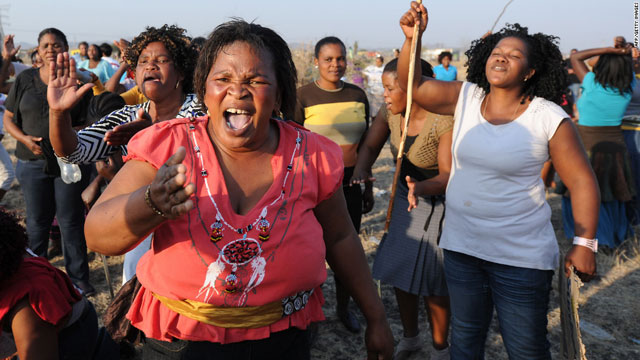
Wives and mothers of Marikana miners demand cops get out! (Photo: Agence France-Presse)
Today
the Randlords continue to subjugate
black workers as in the heyday of
apartheid slavery. Former ANC Youth
League president Julius Malema played
on this, showing up in Marikana
demanding that the mines be
nationalized. While his supporters
wore red T-shirts proclaiming
“Capitalism sucks,” Malema is actually
a populist bourgeois politician who
“is looking for a massive bailout for
his friends who own unprofitable
mines” (Ayanda Kota in the San
Francisco Bay View, 18 August).
In contrast to the reformist slogan of
nationalization, proletarian
revolutionaries are for expropriation
of the mines without compensation.
And class-conscious miners should call
for workers committees to open the
books of the mining
conglomerates (which loot South Africa
with their notorious “transfer
pricing”) while seeking to occupy
the mines and impose workers
control and workers safety
committees with the power to
shut down the mines to prevent deadly
accidents.
A program of transitional demands
would include the call for a shorter
workweek with no loss in pay, in
order to fight mass unemployment,
which particularly affects South
African youth; along with demands for
free, 24-hour day care to
relieve the burdens on working women;
full citizenship for all immigrants,
to provide legal rights for the
millions of workers from Lesotho,
Mozambique and elsewhere in the
region; and other demands pointing to
the need for international socialist
revolution. To this end, a fight must
be waged within COSATU to oust the
sellout bureaucracy and forge a
class-struggle leadership of labor.
Given the degree of union
subordination to the ANC regime,
splits cannot be ruled out. But above
all it is necessary to break labor
from the nationalist popular front
and build an internationalist,
Leninist-Trotskyist, revolutionary
workers party to fight for a black-centered
workers government in a socialist
federation of southern Africa.
■
To contact the Internationalist Group and the League for the Fourth International, send e-mail to: internationalistgroup@msn.com